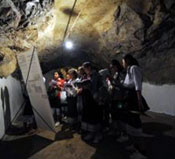 Laos opens Vietnam war "city" housed in network of caves to tourists
Laos opens Vietnam war "city" housed in network of caves to tourists
VIENGXAY, Laos (AFP) — Hidden deep inside the jungle-covered carst mountains of northern Laos lies a secret cave city where revolutionary leaders survived nearly a decade of US bombing during the Vietnam war.
Now, over 30 years since the conflict ended, the communist country has opened up the remote wartime hideaway to tourism, hoping to bring development to this explosives-littered and dirt-poor part of the country.
The network of almost 500 caves was home to 23,000 people and boasted all the facilities of a city, including not just bomb shelters but also shops, schools, a printing press and a hospital cave staffed by Cuban doctors.
Hundreds of troops and villagers could shelter in the cathedral-sized Elephant Cave, where propaganda movies were screened and visiting theatre troops from socialist countries performed to bolster battlefield morale…
Smaller caves connected by tunnels were the homes of Communist Party chief Kaysone Phomvihane and his politburo, set near an emergency shelter with a Russian oxygen generating machine in case of a gas attack, which never came.
"This is the birthplace of modern Laos," said Siphanh Vandouayang, who spent much of his childhood here and now runs the local visitors’ centre.
"Most of the members of the revolutionary leadership lived and studied here."
The picturesque landscape of limestone peaks and rice fields between 1964 and 1973 became the most heavily bombed place on earth as US jets targeted Pathet Lao fighters and North Vietnamese supply lines, he recalled.
"Every eight to 10 minutes the American aircraft bombed, between 6am and 5pm," he said. "At 7pm they came back to fire rockets and for surveillance for the next day’s bombing… People farmed only between 4am and 6am."
For decades after the war, which ended in communist victories in 1975 in Vietnam, Cambodia and Laos, the area remained off limits to foreigners and the site of political re-education camps that are still shrouded in mystery.
As Laos has opened up since the 1990s, the occasional backpacker has strayed to Viengxay, two days’ drive from the capital Vientiane, in northeastern Houapanh province, and 55 kilometres (34 miles) from the Vietnamese border.
Laos is hoping to change this and, with the help of foreign development groups, turn the historic site into a war-theme tourist stop, similar to the Cu Chi tunnels of southern Vietnam and Cambodia’s horrific Killing Fields.
Laos has so far opened only seven caves, most of them the former homes of communist leaders, where busts of Lenin, kerosene lamps and weathered communist tracts are among the few historical artefacts on display.
But the mountains hide more secrets to be opened and discovered by outsiders as more funding and tourist dollars arrive, including an underground sewing factory, bank, bakery, fuel depot and a radio station.
"Not many foreign tourists have come to Viengxay over the years because it’s so remote. We call it a hidden city," said Janet Pontin, a heritage expert with the UN World Tourism Organisation working here.
"What Viengxay needs is economic development because Houapanh is the poorest province in Laos. The great thing about what happens when tourists come to visit Viengxay is that their visit benefits local people."
As part of the project, run by Dutch development agency SNV, historians are now recording oral histories of people who survived the war years, such as garlic farmer Bounthong, who lives near the Cuban hospital cave.
"During the war, US planes flew intense bombing missions," said Bounthong, who like many Lao people has only one name. "Many soldiers and villagers died, 300 in my district alone. If not for the caves, many more would have died."
Despite the war’s deadly legacy, he said he now welcomes foreign visitors.
"I am not angry with the foreigners who visit here because now our country is open," he said. "In the past I knew only foreigners who were armed to make war in Laos. My ideas have changed since the war ended."
Go to original article
"Go to Original" links are provided as a convenience to our readers and allow for verification of authenticity. However, as originating pages are often updated by their originating host sites, the versions posted on VT may not match the versions our readers view when clicking the "Go to Original" links.
The opinions expressed on VT are those of the authors and do not necessarily reflect those of the staff individually or as a whole.
(In accordance with Title 17 U.S.C. Section 107, this material is distributed without profit to those who have expressed a prior interest in receiving the included information for research and educational purposes. VT has no affiliation whatsoever with the originator of this article nor is VT endorsed or sponsored by the originator. Any opinions expressed by the author(s) are not necessarily those of VT or representative of any staff member at VT.)
ATTENTION READERS
We See The World From All Sides and Want YOU To Be Fully InformedIn fact, intentional disinformation is a disgraceful scourge in media today. So to assuage any possible errant incorrect information posted herein, we strongly encourage you to seek corroboration from other non-VT sources before forming an educated opinion.
About VT - Policies & Disclosures - Comment Policy




